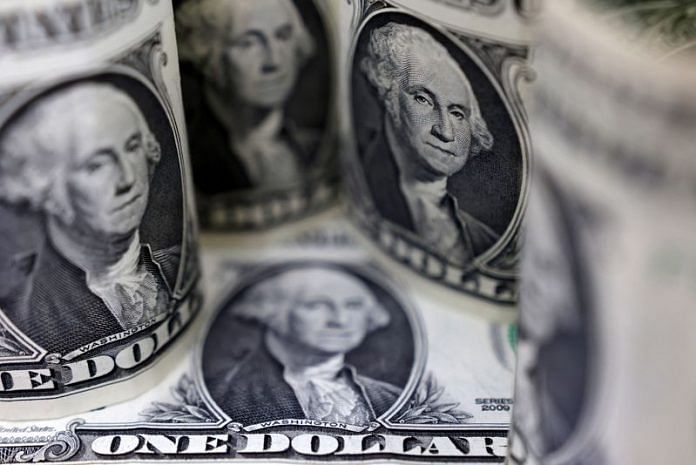By Alden Bentley and Alun John
NEW YORK/LONDON (Reuters) -The U.S. dollar edged higher on Wednesday, taking in stride the release of minutes from the Federal Reserve’s September meeting that showed a substantial majority of policymakers backed its outsized 50-basis point rate cut.
Traders also digested comments from Fed officials and kept their powder dry for Thursday’s release of September’s consumer price index.
Investors were confident that the central bank will not continue easing so aggressively, and minutes from the Federal Open Market Committee were out of date after last Friday’s robust nonfarm payroll data caused markets to reprice near-term Fed rate cut expectations.
“The market has been building up to the minutes for a couple of days now, both the minutes and the inflation report. So, the dollar index has been moving up higher and clearly the tipping point was the strong U.S. jobs report,” said Amo Sahota, executive director at Klarity FX in San Francisco.
Sahota said it looked like Fed Chair Jerome Powell had to convince more participants than originally thought who had supported only a quarter-point cut. The minutes said “a few others indicated they could have supported such a decision.”
Only one, Fed Governor Michelle Bowman, actually dissented.
Dallas Federal Reserve Bank President Lorie Logan on Wednesday said she supported last month’s outsized interest-rate cut but wants smaller reductions ahead, given “still-real” upside risks to inflation and “meaningful uncertainties” over the economic outlook.
On the docket later are Boston Fed President Susan Collins and San Francisco Fed President Mary Daly.
Looking at the fed funds futures term structure, traders see about an 83% chance of a 25 basis point cut at the November meeting, and about 50 bps more by year-end, according to LSEG calculations. Odds for the Fed standing pat next month are 17%.
The euro extended its sell-off to a two-month low against the greenback, and was last off 0.36% at $1.094. Dollar/yen rose 0.72% to 149.26, topping Monday’s high to reach its priciest since Aug. 15.
The dollar index, which measures the greenback against a basket of currencies including the yen and the euro, extended its rally to the highest since Aug. 16 and was 0.38% higher at 102.88.
The yen has been whiplashed since Japan’s new Prime Minister Shigeru Ishiba, known for being a critic of easy monetary policy, surprised markets with recent remarks that the nation is not ready for further rate hikes.
Ishiba has set a snap election for Oct. 27, ahead of the Bank of Japan’s October monetary policy meeting and the U.S. presidential election on Nov. 5.
Worries about demand from China have been a theme all week, amid disappointment in the follow-up to last month’s stimulus measures. Especially hard hit on Wednesday were the Australian and New Zealand currencies.
“We’ve got the CPI tomorrow. I think that China’s announcement that they are going to make another announcement Saturday, the Ministry of Finance, that’s important,” said Marc Chandler, chief market strategist at Bannockburn Global Forex in New York, adding “we’re not seeing much of an effect here today in the dollar block.”
China’s finance ministry on Wednesday called a press conference for Saturday on fiscal policy, raising expectations of stimulus, a day after a news conference from the state planner – the National Development and Reform Commission – disappointed markets by yielding no major new stimulus details.
But that did little for the Aussie, which fell 0.43% vs the U.S. dollar to $0.6716. The yuan weakened to 7.0810 per dollar.
The New Zealand dollar was one of the biggest movers on Wednesday after the Reserve Bank of New Zealand cut interest rates by 50 basis points.
The kiwi tumbled 1.32% to US$0.6057 and hit its lowest since Aug. 19.
“We see mounting near-term headwinds (for the New Zealand dollar against the U.S. dollar) including hawkish repricing for the Fed, potential geopolitical escalation, de-risking ahead of the U.S. election, exhausted momentum in terms of trade, and now a more-dovish-than-expected RBNZ,” said Lenny Jin, global FX strategist at HSBC.
“Potentially strong fiscal stimulus from China is an upside risk but the (Australian dollar) is set to benefit more.”
Against the Swiss franc, the dollar strengthened 0.42% to 0.86, reaching its highest since Aug. 20. Sterling weakened 0.25% to $1.3071, hitting it cheapest since Sept. 12.
In cryptocurrencies, bitcoin fell 1.60% to $61,348.93. Ethereum declined 0.81% to $2,422.42.
(Reporting by Alden Bentley, Alun John and Brigid Riley; Editing by Kim Coghill, Peter Graff, Chizu Nomiyama and Jonathan Oatis)
Disclaimer: This report is auto generated from the Reuters news service. ThePrint holds no responsibilty for its content.




